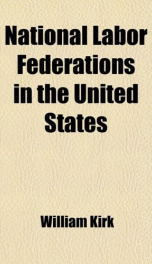national labor federations in the united states

Purchase of this book includes free trial access to www.million-books.com where you can read more than a million books for free. This is an OCR edition with typos. Excerpt from book: CHAPTER III. Functions. From a review of the structural differences existing among general labor federations, outlined in the preceding chapter, attention may now properly be directed to a comparison of their respective activities in certain typical fields. This will involve a survey of the policies of the several federations with reference to (a) jurisdictional disputes, (b) the enlistment of new members, (c) the union label, (d) cooperation, (e) boycotts and strikes, (/) the eight-hour day, and (g) politics and legislation. (a) One of the chief advantages of a strong federation is its ability to adjust the frequent jurisdictional disputes that arise between unions. A serious weakness of trade unions in their relation with one another has heretofore been the attempts of aggressive organizations to gain larger jurisdiction, regardless as to whether the added control has or has not been at the expense of other unions. One purpose of federation is, therefore, to bring about a clear understanding so that each union may control a certain trade or industry without interference from other unions. In marked contrast to the effective power of the general executive board of the Knights of Labor to settle jurisdictional disputes, the executive council of the American Federation is narrowly limited in this field. Acting in a judicial capacity the council has little power to enforce its trade jurisdiction decisionsthe real test of authority. The severest penalty which may be inflicted on a union for disobedience is suspension or expulsion from the federation; and this is not considered a great hardship. An example will serve to make the gravity of the situation clearer. The United Brewery Workmen included in their organization engineers and firemen. The national unions of these ...
Info about the book
Author:
Series:
Unknown
ISBN:
1177913046
Rating:
5/5 (2)Your rating:
0/5
Languge:
English
Users who have this book
Users who want this book
What readers are saying
What do you think? Write your own comment on this book!
write a commentGenre
if you like national labor federations in the united states try:
Other books by this author
Do you want to read a book that interests you? It’s EASY!
Create an account and send a request for reading to other users on the Webpage of the book!



